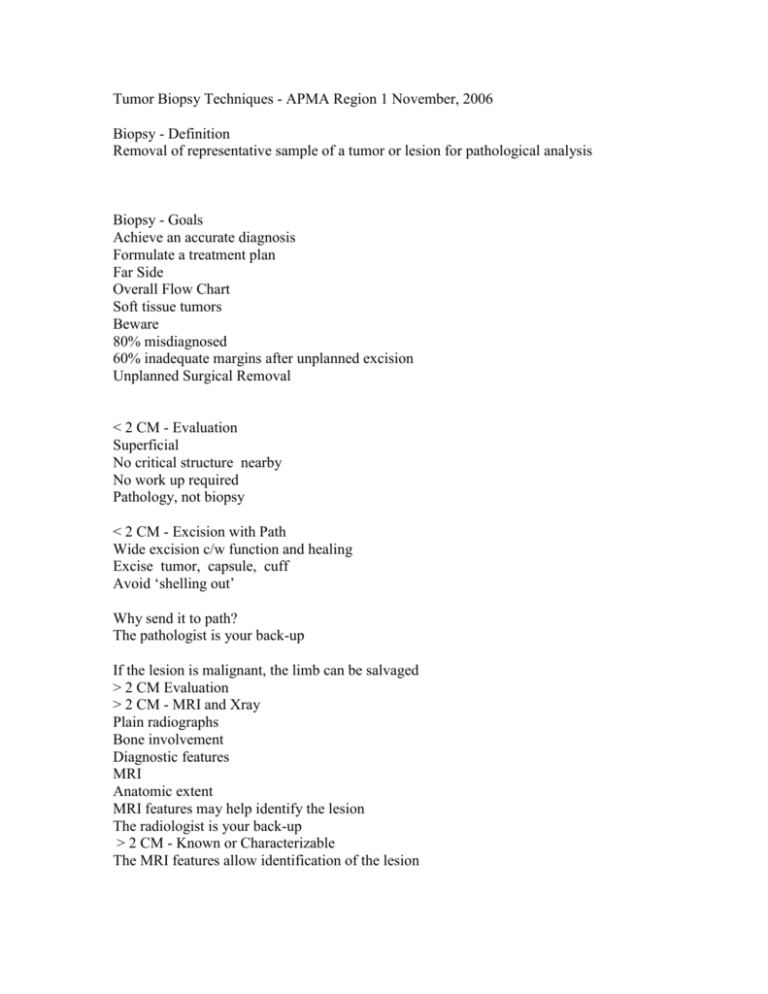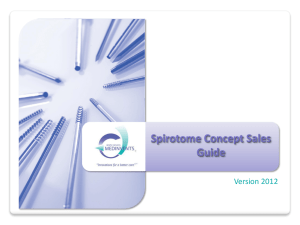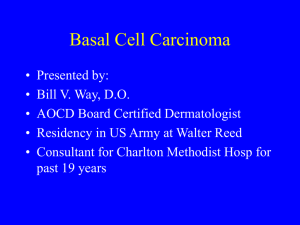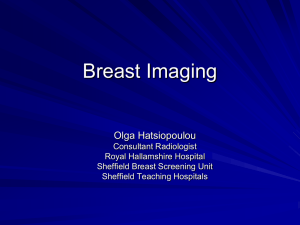Tumor Biopsy Techniques - APMA Region 1
advertisement

Tumor Biopsy Techniques - APMA Region 1 November, 2006 Biopsy - Definition Removal of representative sample of a tumor or lesion for pathological analysis Biopsy - Goals Achieve an accurate diagnosis Formulate a treatment plan Far Side Overall Flow Chart Soft tissue tumors Beware 80% misdiagnosed 60% inadequate margins after unplanned excision Unplanned Surgical Removal < 2 CM - Evaluation Superficial No critical structure nearby No work up required Pathology, not biopsy < 2 CM - Excision with Path Wide excision c/w function and healing Excise tumor, capsule, cuff Avoid ‘shelling out’ Why send it to path? The pathologist is your back-up If the lesion is malignant, the limb can be salvaged > 2 CM Evaluation > 2 CM - MRI and Xray Plain radiographs Bone involvement Diagnostic features MRI Anatomic extent MRI features may help identify the lesion The radiologist is your back-up > 2 CM - Known or Characterizable The MRI features allow identification of the lesion Lipoma PVNS Hemangioma Ganglion cyst 85% correct Excise > 2 CM Unknown or Uncharacterizable The features of the MRI do not allow identification of the lesion with a high degree of certainty Synovial sarcoma Clear cell sarcoma Epithelioid sarcoma Uncharacterizable by MRI Biopsy is the last step Biopsy only Open Biopsy - General Techniques Incision size Use the smallest longitudinal incision that allows a full view of your goal Tourniquet use Do not exanguinate Release prior to closure Open Biopsy - General Techniques Do not raise flaps Do not retract more than needed Do not use intramuscular planes Do not dissect, simply incise with the bovie on cautery Open Biopsy - General Techniques Incise directly down - thin layer by thin layer with the bovie Color change red to salmon Salmon to grey or tan/white Biopsy the tumor not the capsule Cut a cube out with the knife Biopsy – Closing the Deal Make sure the wound will stay closed Splints, casts or pressure dressings Postoperative activity restriction Three Kinds of Bone Tumors Latent No pain or symptoms prior to discovery Narrow zone of transition, sclerotic rim, no periosteal reaction, no soft tissue mass Latent bone tumors Non-ossified fibroma Enchondroma Lipoma Unicameral bone cyst Latent Lesions May Be Observed Without Biopsy Diagnosis by history and imaging studies Biopsy not required to confirm diagnosis Tumor poses no risk to the pt. Observe 12-24 months Active Bone tumors with active appearance Giant cell tumor Aneurysmal bone cyst Chondromyxoid fibroma Chondroblastoma Active lesions require biopsy Growth and damage Treatment plan needed Biopsy required Biopsy will lead to correct treatment plan Biopsy and removal as staged procedures Aggressive Progressive growth but only moderate pain Moth-eaten or permeative appearance, wide zone of transition, marked periosteal reaction, extensive cortical destruction, soft tissue mass Management of aggressive bone lesions Staging studies needed MRI, CT, CCT, BS, Labs Biopsy required Biopsy will lead to correct treatment plan Biopsy and removal as staged procedures Osteoblastoma Ewing sarcoma Osteosarcoma Chondrosarcoma (Infection) Work-up: Xray /MRI / CT / BS Complete imaging studies before biopsy Xray + MRI for soft tissue lesions Xray + CT (MRI) for bone lesions Additional studies based on the differential diagnosis Children’s Bone and Soft Tissue Tumors Special tumors, problems, and risks Chondromyxiod fibroma Osteoid osteoma, osteoblastoma Ewing sarcoma Tumors in Children should be referred to a subspecialist Ewing’s Hindfoot -33% survival Forefoot – 70% survival With mets – 0% Refer Non-Tumors (PVNS) PVNS Gout Stress fracture or missed fracture Subchondral cyst Gout, Stress Fracture Non tumors – biopsy not necessary Diagnosis based on labs, imaging studies, serial xrays, etc Biopsy often unrewarding Biopsy Only -Without Removal Allows the pathologist the time needed Prepares the surgeon and the patient for the definitive treatment Reduces risk Bone Biopsy - General Techniques 1 Incision size Use the smallest longitudinal incision that allows you a full, unimpeded view of your goal Tourniquet use Controversial Do not exanguinate with an Esmarch Release prior to closure Hazards of Biopsy Biopsy has many potential complications: Nondiagnostic material Errors in interpretation of histological material Contamination of uninvolved compartments or spread of tumor in hematoma Bone Biopsy - General Techniques 4 Drill a round hole Make it into an oval as needed Avoid stress risers Biopsy - General Techniques 5 The purpose of the frozen section is to make sure you have adequate tissue for diagnosis “Biopsy all cultures, culture all biopsies” Hopefully the pathologist will receive the sample fresh Biopsy - General Techniques 6 Biopsy - General Techniques 7 Make sure the wound will stay closed Splints, casts or pressure dressings Postoperative activity restriction Biopsy of Soft Tissue Tumors - Special Considerations Unplanned excision of soft issue tumors leads to cancer being left behind 35% had residual tumor (Noria JBJS 1996) Important staging data were unavailable The chance of misdiagnosis and mismanagement is much higher Seems to be highest with small subcutaneous masses Complications of Biopsy MSTS studies in 1982 and 1996 14% major error rate errors twice as likely in outside biopsies 19% resulted in an alteration in care Amputations in 5% No change in 14 years! MSTS Study Mankin et al, MSTS 1982 - 329 pts Major errors in diagnosis 18.2% Complications occurred in 17.3% 4.5% had unnecessary amputation Mankin et al, MSTS 1996 - 597 pts Major errors in diagnosis 13.5% Complications occurred in 15.9% 3% had unnecessary amputation MSTS Study Adverse events were far more frequent when biopsy was preformed in the referring institution Recommendation in both studies was that biopsy of sarcomas should be performed in a musculoskeletal tumor center Hazards of Biopsy Biopsy has many potential complications: Nondiagnostic material Errors in interpretation of histological material Contamination of uninvolved compartments or spread of tumor in hematoma CPT Codes for Tumors Reasons Not to Do a Biopsy A Biopsy is Not… Hazards of Biopsy Biopsy is Not a “No-Brainer” Preparing the Patient Preparing the OR & Staff “To urinquet” or not? Surgical Approach Sampling the Lesion Hemostasis and Closure Post-op Care www.bonetumor.org/APMA/ Thank You









